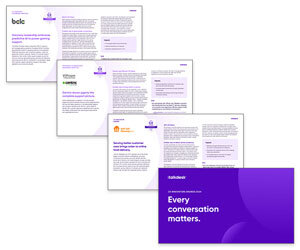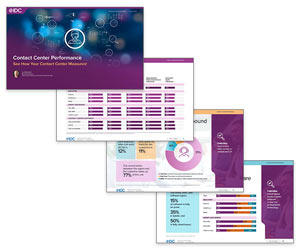Celia Cerdeira at Talkdesk explores the types of contact centre technology, its benefits, and the emerging trends shaping its future.
At every stage of the buying journey, companies have an opportunity to connect with customers. Before a purchase, they can answer questions and help potential buyers weigh their options.
During the purchase, it’s about making things easy: removing roadblocks, handling last-minute concerns, and guiding the next steps.
After the purchase, staying connected matters even more. Keeping existing customers costs four to five times less than finding new ones, so building strong relationships with past buyers is key.
This ongoing relationship management, commonly known as customer relationship management (CRM), is where a contact centre becomes invaluable.
A contact centre is a centralized platform that helps businesses manage inbound and outbound customer communications across multiple channels.
What Is Contact Centre Technology?
Contact centre technology is the suite of tools and systems that help agents manage customer interactions in an on-premises setup or a virtual, cloud-based environment. Modern solutions play a pivotal role.
Modern contact centre technology also incorporates advanced features like AI-powered virtual assistants, predictive analytics, and sentiment analysis.
By integrating these tools into a unified system, businesses can boost operational efficiency, deliver consistent service quality, and gain actionable insights to enhance their customer engagement strategies.
Let’s explore some of the most popular types of contact centre technologies.
1. Artificial Intelligence to Improve Customer Experience
AI improves every stage of contact centre operations, enabling faster, more personalized interactions between brands and customers in three main ways.
- Intelligent routing. AI assesses customers’ needs and quickly matches them with the best agent or digital experience, leading to faster resolutions and less frustration.
- Self-service AI. Automated tools offer 24/7 support, using conversational AI to answer questions and smoothly pass complex issues to an agent with all the context intact.
- Agent AI copilot. AI assists agents during live interactions by offering real-time guidance and insights, helping them resolve issues quickly and improve customer satisfaction.
AI-powered contact centre technology improves overall customer satisfaction, making interactions faster, easier, and more personal. One of the biggest wins? Shorter interaction times.
AI gives agents the tools and insights they need to solve more problems on the spot, cutting down on the back-and-forth and eliminating frustrating waits or transfers. With features like intelligent routing and self-service options, customers get to the right resource instantly.
2. Omnichannel Engagement for Seamless Service Across Every Platform
Omnichannel contact centre technology integrates all communication channels – phone, chat, email, SMS, and social media – into one unified system.
It ensures that no matter how or where customers reach out, their experience feels seamless and personalized. By having every communication option work together, omnichannel engagement has become a game-changer for improving contact centre performance.
A strong omnichannel experience offers several key benefits:
- Integrations – All communication channels are connected, allowing customer data, purchase history, and preferences to flow seamlessly between them.
- Consistency – Customers receive the same information, branding, pricing, and promotions building trust and reliability in every interaction.
- Personalization – By leveraging customer data and preferences, contact centres can tailor interactions to offer relevant recommendations, resolve issues quickly, and improve satisfaction.
3. CRM Integration to Connect Customer Workflows
Integrating contact centre technology with CRM software is a powerful way to streamline an entire customer experience strategy.
By connecting these systems, businesses can unify customer data, communication tools, and workflows into a single, intuitive interface. Plus, agents have immediate access to the information they need when they need it.
Let’s dive deeper into the benefits of CRM integration:
Enhanced customer experience. Integrating a contact centre with a CRM ensures agents have this information at their fingertips, empowering them to personalize their interactions, anticipate customer needs, and offer tailored solutions.
- Real-time access to data. Agents have instant access to customer interaction history, purchases, and feedback ensuring they’re always equipped with up-to-date information for better problem-solving.
- Accurate customer interactions. Automating data entry through CRM integration reduces errors and keeps customer information current.
- Unified reporting and analytics. With CRM integration, organizations can gather and analyse data from multiple sources, creating a comprehensive view of customer interactions.
4. Interaction Analytics to Make Future Interactions Even More Meaningful
One of the biggest advantages of modern contact centre technology is its ability to track and analyse customer interactions in both real time and retrospectively.
Interaction analytics lets businesses dig into past conversations to see what’s working, spot pain points, and find opportunities to improve the overall customer experience.
Plus, real-time insights like mood insights let organizations monitor live interactions to help offer instant feedback.
With this data, companies can measure key performance indicators (KPIs) like first-call resolution, average handle time, and customer satisfaction (CSAT).
Plus, they can create dashboards to visualize this information – everything from trends in customer feedback to conversational insights – making it easy to share across teams.
When everyone in the company has access to these reports, it’s easier to work together and stay focused on delivering a great experience.
5. Sentiment Analysis That Creates Agile Customer Interactions
In the traditional call centre model, agents typically gauge how customers feel about their experiences through tone and verbal cues during live phone calls.
However, as more customer interactions shift to digital channels, it’s become harder to assess emotions and satisfaction levels in real time.
Sentiment analysis uses advanced algorithms to analyse customer interactions and uncover how customers feel about a brand, its products, and its service allowing businesses to adapt quickly and provide more meaningful responses. Here are some key features of sentiment analysis:
- Mood detection – Detects subtleties in tone, context, and language patterns providing deeper insights into specific emotions and complex human feelings such as frustration, gratitude, or excitement.
- Intent analysis – Identifies what a customer is trying to achieve – whether it’s resolving an issue, making a purchase, or asking a general question.
- Trend monitoring – Uncovers patterns and trends, such as increased dissatisfaction following a product launch or a spike in positive feedback after a new feature is introduced.
- Brand monitoring – Tracks brand mentions across platforms like websites, app stores, and social media, so businesses can address negative comments before they escalate.
Contact Centre vs. Call Centre Technology: Where Does Legacy Software Fall Short?
Traditionally, delivering a great customer experience was all about providing excellent service through a call centre.
For years, this model worked, but as customer expectations evolved, the limitations of even the most successful call centres became clear:
- Long queues left customers waiting for extended periods, leading to frustration.
- Traditional IVR systems often used exhaustive and confusing phone menus, making it hard for customers to find the right options.
- No self-service options forced customers with simple queries to wait unnecessarily for an agent.
- Multiple transfers meant customers frequently spoke with several agents before reaching someone qualified to help.
- Repeated explanations required customers to repeat their concerns to each new agent, wasting time and causing frustration.
The contact centre model addresses all these pain points and enhances customer experiences in every regard:
- Reduced queue times – Contact centres offer customers more ways to connect with a brand, like chatbots, social media messaging, and email, easing the load on phone lines.
- Agentic AI for hyperpersonalization – AI eliminates layered phone menus by creating faster, personalized interactions.
- 24/7 self-service options – Chatbots let customers handle simple queries anytime, without needing an agent.
- Intelligent routing – Built-in AI matches customers with the best agent for their issue, reducing transfers and wait times.
- Comprehensive customer context – AI copilots give agents a full history of the customer’s interactions across all channels, so customers never have to repeat their concerns.
While the goal of satisfying customer concerns remains the same, contact centre technology modernizes the approach, delivering a faster, more satisfying experience.
Where Is Contact Centre Technology Located?
On-premises call centre technology was once the go-to solution for organizations looking to streamline customer service.
However, this required significant investments in hardware, infrastructure, and maintenance. Today, brands can choose cloud-based contact centre technology.
On-Premises Contact Centre Technology: More Local Control Comes With Higher Costs and Manual Maintenance
On-premises contact centre technology refers to customer service systems hosted and managed on an organization’s own physical infrastructure.
This setup involves the installation of hardware, such as servers and networking equipment, and software that operates entirely within the company’s data centres.
Businesses using on-premises solutions are responsible for maintaining and upgrading the system themselves, often with dedicated IT staff.
Benefits of on-premises contact centre technology:
- Full Control – Businesses have complete control over their contact centre infrastructure, including custom configurations and security protocols.
- Data Security – Since all customer data is stored locally, organizations can maintain tighter security measures to meet compliance needs.
- Customization – On-premises solutions can be tailored to meet the specific requirements of an organization’s unique workflows or industry standards.
- Reliability – When managed effectively, on-premises systems can offer consistent performance without relying on external internet connectivity.
However, on-premises contact centre technology also comes with huge drawbacks, including:
- High Upfront Cost – Significant investments in hardware, software, and installation are required to set up the system.
- Maintenance Burden – Ongoing updates, repairs, and system monitoring are the organization’s responsibility.
- Limited Scalability – Expanding capacity often involves purchasing and installing additional hardware, making it less agile than cloud-based solutions.
- Accessibility Constraints – On-premises systems are less flexible for remote or hybrid work environments, which may limit agent availability.
Cloud Contact Centre Technology: Internet-Reliant Systems With Lower Upfront Costs and Greater Scalability
Cloud contact centre technology is a customer service solution hosted on remote servers and accessed over the internet. Unlike on-premises systems, cloud-based platforms don’t require businesses to invest in or maintain physical hardware.
Instead, providers manage the infrastructure and software, delivering updates, maintenance, and scalability on demand. Organizations simply pay a subscription fee, making this an accessible and flexible option.
Consider the main benefits of cloud contact centre technology:
- Lower Upfront Costs – No need to purchase or maintain expensive hardware, businesses only pay for what they use.
- Scalability – Organizations can easily scale their contact centre operations up or down to meet changing needs without significant delays or costs.
- Remote Accessibility – Agents can work from anywhere with an internet connection, making it ideal for hybrid or fully remote teams.
- Faster Implementation – Cloud solutions can be deployed very quickly compared to the lengthy installation process of on-premises systems.
- Continuous Updates – Providers handle software updates and maintenance, ensuring the system is always up-to-date and secure.
Now, let’s go over the limitations of cloud contact centre technology:
- Internet Dependence – The system relies on stable internet connectivity, which can be a risk in areas with unreliable service.
- Data Security Concerns – Since data is stored remotely, organizations must trust their provider’s security measures and compliance with regulations.
When compared to on-premises systems, cloud-based contact centres are 27% more cost-effective and experience 35% less downtime.
The flexibility and adaptability to evolving customer needs make cloud-based solutions a smart, modern choice for businesses.
Six Powerful Benefits of Contact Centre Technology
Contact centre technology offers a wide range of advantages, both for brands and the customers they serve. Let’s dive into some of the most powerful benefits that set contact centre technology apart from traditional CX solutions.
How Does Contact Centre Technology Improve the Customer Experience?
96% of customers say inadequate customer service experiences impact their loyalty to a brand, and 76% would abandon a brand after three negative service experiences. Take a look at how contact centre technology can improve customer experience:
1. Customers Can More Easily Connect With Brands They Care About
Contact centre technology simplifies how customers connect with their favourite brands. Customers can choose the communication method they’re most comfortable with, eliminating the frustration of limited options.
2. Customers Can Connect With Brands in a Fraction of the Normal Time
Contact centre technology significantly reduces wait times by leveraging agentic AI features like intelligent routing and self-service options.
3. Customers Are Satisfied by Their Interactions With Their Favourite Brands
Contact centre technology makes customer service faster and easier. By cutting down wait times, simplifying interactions, and removing common frustrations, customers leave feeling valued and happy.
How Does Contact Centre Technology Make Every Agent Your Best Agent?
Contact centre technology gives every agent the tools to deliver exceptional service. With features like AI copilots, access to customer history, and mood analysis even newer agents can handle interactions like qualified brand ambassadors.
1. Agents Become More Productive
Contact centre technology streamlines workflows, automates repetitive tasks, and provides agents with all the information they need at their fingertips.
2. Agents Can Solve More Customer Queries Without Escalating
Equipped with tools like AI copilots, real-time insights, and access to a customer’s complete interaction history, agents can confidently handle more queries without needing to escalate.
3. Agents Can Access Detailed Information About the Customer Experience
When agents have access to customer data, they can see the full picture – past interactions, preferences, and any issues a customer has faced. This helps them personalize their approach, resolve problems faster, and make the whole experience smoother.
This blog post has been re-published by kind permission of Talkdesk – View the Original Article
For more information about Talkdesk - visit the Talkdesk Website
Call Centre Helper is not responsible for the content of these guest blog posts. The opinions expressed in this article are those of the author, and do not necessarily reflect those of Call Centre Helper.
Author: Talkdesk
Reviewed by: Megan Jones
Published On: 18th Feb 2025
Read more about - Guest Blogs, Celia Cerdeira, Talkdesk






 Talkdesk is a global customer experience leader for customer-obsessed companies. Our contact center solution provides a better way for businesses and customers to engage with one another.
Talkdesk is a global customer experience leader for customer-obsessed companies. Our contact center solution provides a better way for businesses and customers to engage with one another. 
































